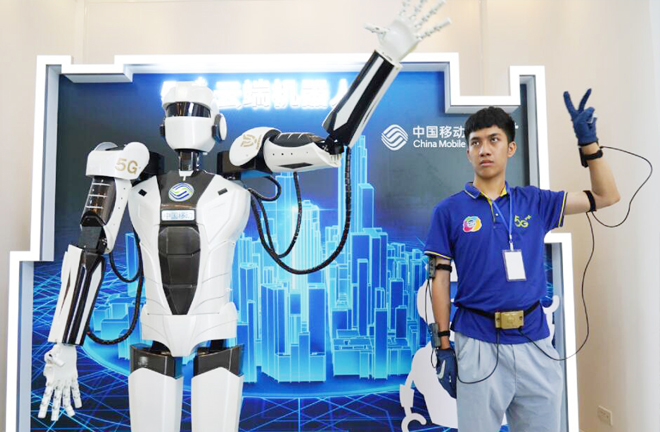China’s S&T industry needs greater efficienct innovation

A robot capable of simulating human movements using a 5G network Photo: XINHUA
The economic reality of China has made it more urgent for us to speed up scientific and technological innovation. Scholars proposed that future scientific and technological system reform should be oriented towards major issues. We should leverage China’s institutional strength when constructing a nationwide new-type scientific and innovation system, and we should actively enhance the overall efficiency of China’s system of scientific and technological innovation.
Zhong Weijun, secretary of the party committee of the School of Economics and Management at Southeast University, said he was impressed by the four improvements of China’s scientific and technical system reform. First, the autonomous rights and usufruct of scientific and technical personnel in dealing with their own achievements has been broadened, which helps to encourage them to innovate. This was achieved through reforming the mechanisms of project review, institutional assessment and talent evaluation.
Second, with more favorable innovation policies in place and an innovation-friendly environment, the building of an enterprise-oriented and market-oriented technology innovation system featuring close industry-university research cooperation has gathered pace.
Third, original fundamental research has strengthened and more pioneering innovative products have been created. This has been achieved by increasing financial investment and guiding enterprises to increase input.
Fourth, international cooperation in scientific and technological innovation along the Belt and Road has been strengthened with more exchanges in science, technology and culture, jointly built laboratories, cooperation among science parks and technology transfer.
Chen Fan, a professor from the College of Marxism at Northeastern University, said that core technologies are essential as they help maintain a country’s safety and social stability when there is a major social disaster, and they increase the country’s international competitiveness in technology and innovation. To acquire core technologies and improve the technology and innovation system’s ability to respond to emergencies and act according to circumstances, China should fully engage all parties through institutional mechanism reform and the nationwide new type system.
The new type nationwide system is new for three reasons: first, governments will begin to play a bigger role in stimulating and coordinating, instead of directly interfering in scientific projects with administrative instructions; second, the system will have a clearer boundary in that it mainly focuses on complex product systems, underlying technologies and core technologies concerning the national economy, people’s livelihoods and industries’ core competitiveness; third, the system will be able to resolve problems regarding cross-department collaboration more effectively, said He Jun, a research fellow from the Institute of Industrial Economics at the Chinese Academy of Social Sciences .
Chen Qiang, a professor form Tongji University School of Economics and Management, said that in order to enhance scientific and technological innovation, make technological breakthroughs and improve the industry’s ability to systemize, we must build mechanisms for scientific and technological strategy-making and decision-making, science and technology programs and organizational systems, resource allocation and safeguards, transformation of government functions and policy supply, the nationwide new type system for core technology fields, strategic technology strength cultivation, and regional innovation and international cooperation.
edited by WENG RONG

 PRINT
PRINT CLOSE
CLOSE